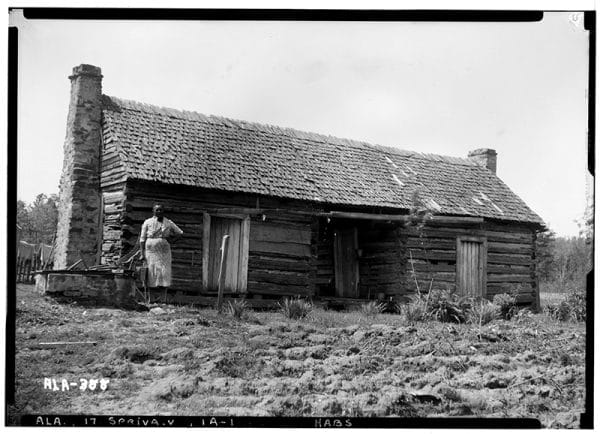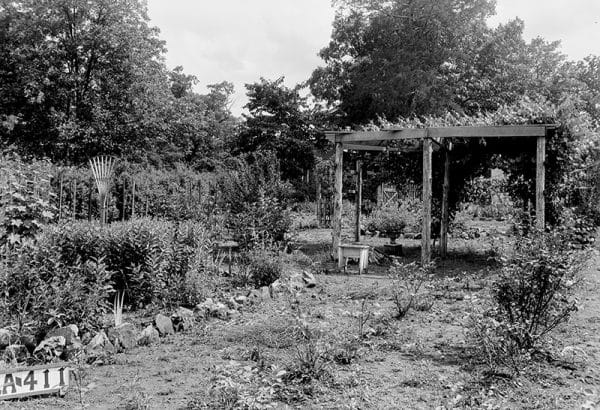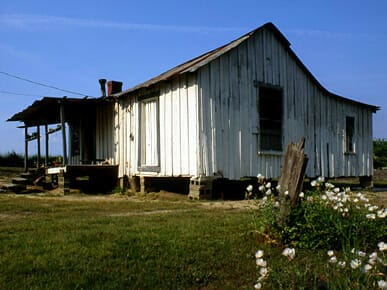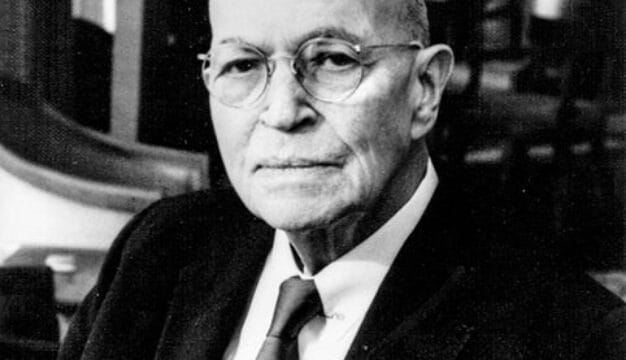Plantation Agriculture
 Dogtrot Cabin at Belle Mont Plantation
Plantation agriculture was a form of large-scale farming that was most prevalent during the colonial and antebellum periods of American history. Plantations typically ranged from approximately 500 to 1,000 or more acres of land and produced one or two crops—and sometimes livestock—for sale. In antebellum Alabama, the primary crop on such plantations was the short-staple variety of cotton. Plantations required a large, stable work force that initially consisted of indentured servants but eventually shifted almost entirely to enslaved labor. Cotton plantations existed in many parts of Alabama, but the vast majority were located in the Black Belt region. Those plantations that raised cattle were located largely in the southern piney woods area, a region in the lower third of the state known for the great numbers of native long-leaf pine trees.
Dogtrot Cabin at Belle Mont Plantation
Plantation agriculture was a form of large-scale farming that was most prevalent during the colonial and antebellum periods of American history. Plantations typically ranged from approximately 500 to 1,000 or more acres of land and produced one or two crops—and sometimes livestock—for sale. In antebellum Alabama, the primary crop on such plantations was the short-staple variety of cotton. Plantations required a large, stable work force that initially consisted of indentured servants but eventually shifted almost entirely to enslaved labor. Cotton plantations existed in many parts of Alabama, but the vast majority were located in the Black Belt region. Those plantations that raised cattle were located largely in the southern piney woods area, a region in the lower third of the state known for the great numbers of native long-leaf pine trees.
Colonial Plantations
 Bride’s Hill, Lawrence County
This type of farming had its origins in the latifundia of the ancient Roman world, which were large farms, owned by the wealthy, that used slave or paid labor to grow crops and livestock for sale. During the colonial period, plantation agriculture existed in several regions of the United States—for example, the Hudson River valley of New York—but this type of agriculture eventually became synonymous with the South. During the early seventeenth century, English colonists in the southern part of North America began looking for ways to produce goods or raise crops that could then be sold for a profit in England or Europe. Colonists experimented with manufacturing glass, raising mulberry trees to support silk worms for making silk, growing grapes for wine production, and harvesting trees for timber. The indigenous American tobacco plant, however, quickly emerged as the crop that offered the greatest potential for profitability. Tobacco presented problems, in that its cultivation required hundreds of acres of land, and the plant quickly drained the soil of nutrients. As tobacco fields became unusable, new acreage had to be cleared. Eventually, after nearly two centuries during the colonial period, much of the land in the Chesapeake region of Virginia, Delaware, and Maryland became unproductive. As a result, established planters and new immigrants increasingly looked to the South and West for new opportunities.
Bride’s Hill, Lawrence County
This type of farming had its origins in the latifundia of the ancient Roman world, which were large farms, owned by the wealthy, that used slave or paid labor to grow crops and livestock for sale. During the colonial period, plantation agriculture existed in several regions of the United States—for example, the Hudson River valley of New York—but this type of agriculture eventually became synonymous with the South. During the early seventeenth century, English colonists in the southern part of North America began looking for ways to produce goods or raise crops that could then be sold for a profit in England or Europe. Colonists experimented with manufacturing glass, raising mulberry trees to support silk worms for making silk, growing grapes for wine production, and harvesting trees for timber. The indigenous American tobacco plant, however, quickly emerged as the crop that offered the greatest potential for profitability. Tobacco presented problems, in that its cultivation required hundreds of acres of land, and the plant quickly drained the soil of nutrients. As tobacco fields became unusable, new acreage had to be cleared. Eventually, after nearly two centuries during the colonial period, much of the land in the Chesapeake region of Virginia, Delaware, and Maryland became unproductive. As a result, established planters and new immigrants increasingly looked to the South and West for new opportunities.
Tobacco plantations also needed a large labor force to tend the fields and harvest and prepare the crop for market. At first, colonists used indentured servants, who were people of either European or African descent who worked on average from four to seven years without pay in exchange for their passage to the English colonies. By the eighteenth century, however, owners of large plantations found it more profitable to purchase African slaves, who they would own and use for labor for their lifetime. As Europeans began settling in the Carolinas and Georgia in the late seventeenth and early eighteenth centuries, they began experimenting with raising rice, indigo (used in making dye), and—to a limited degree—long-staple cotton for the market, all of which also required extensive acreage and labor. Thus, the first two centuries of European settlement in the southern part of North American firmly established the definition of a plantation: a very large farm that used enslaved labor to produce a commodity for export.
Plantation Agriculture in Alabama
When European American settlers began pouring into the area now known as Alabama in the early nineteenth century, many brought slaves and sought land that could support large-scale production of a marketable crop. The long-staple cotton produced in coastal Georgia and the Carolinas did not grow well in Alabama, and neither did rice, indigo, sugar cane, or tobacco. The short-staple variety of cotton, however, did fare well in large portions of the state. With the cotton market driven by the Industrial Revolution and boosted by the invention of the cotton gin, which made processing the cotton much easier and faster, short-staple cotton became synonymous with Alabama plantations. In addition, vast amounts of new land opened up to thousands of settlers seeking to grow cotton in Alabama when Native Americans were forced from their ancestral territories after a series of conflicts and treaties with the United States.
 Steamboat in Mobile, ca. 1910
The earliest plantations in Alabama were nearly always established along rivers to make it easier to transport large bales of raw cotton, each of which could weigh several hundred pounds or more. Transporting huge cotton bales on rivers was the most practical method as it was faster and less expensive to move heavy freight on boats than in wagons on rough roads. Various types of large boats carrying cotton were a common sight along Alabama’s navigable rivers during the antebellum period; as a result, small towns that served as receiving depots for cotton also developed along the rivers. The Alabama River was heavily used, especially after steamboats began navigating it in 1820, because it flowed into the port of Mobile. From there, cotton made its way to textile factories in New England or to ports in Europe. As prime cotton lands adjoining rivers became dotted with plantations, however, settlers moved further inland from the rivers onto cotton-producing land in the state’s interior.
Steamboat in Mobile, ca. 1910
The earliest plantations in Alabama were nearly always established along rivers to make it easier to transport large bales of raw cotton, each of which could weigh several hundred pounds or more. Transporting huge cotton bales on rivers was the most practical method as it was faster and less expensive to move heavy freight on boats than in wagons on rough roads. Various types of large boats carrying cotton were a common sight along Alabama’s navigable rivers during the antebellum period; as a result, small towns that served as receiving depots for cotton also developed along the rivers. The Alabama River was heavily used, especially after steamboats began navigating it in 1820, because it flowed into the port of Mobile. From there, cotton made its way to textile factories in New England or to ports in Europe. As prime cotton lands adjoining rivers became dotted with plantations, however, settlers moved further inland from the rivers onto cotton-producing land in the state’s interior.
Alabama’s Black Belt region, which stretches across the center of the state from the Mississippi border to the Georgia border, became synonymous with plantations, cotton, and slavery. At the outbreak of the Civil War, some of the state’s largest cotton plantations—with thousands of acres of fertile land and more than 250 slaves—each were located in this region.
Cotton production reigned supreme in the state before the Civil War. According to the 1850 Census, the state produced 564,429 bales that year and 989,955 bales by 1860. Plantation owners rotated the cotton crop among several fields to allow some to lie fallow and replenish their soil nutrients.
Plantation Labor
Because large-scale cotton production required a tremendous amount of labor, the number of slaves in the state grew from 47,449 in 1820 to 435,080 by 1860. Many of these enslaved Alabamians worked in cotton production, but numerous plantations had fewer than 20 slaves working the land. Most slaves on cotton plantations in Alabama worked under the gang system, which meant they worked at planting, weeding, or picking cotton all day long under the direction of a “driver,” who worked under an overseer. Slaves generally worked from sunrise to sunset and received only short breaks from their work. Failure to work at a steady pace could lead to punishment. Slaves on plantations often maintained a sense of community with one another and fostered lasting relationships through family, friends, and religion that helped them survive the oppressive and usually brutal labor system.
 Robinson-Dillworth Plantation Kitchen Garden
Plantations, which were often many miles away from the nearest town or city, often had to produce for themselves much of what was needed for day-to-day operations. Owners provided housing for slaves, ran a large kitchen for feeding the plantation’s dependents, maintained gardens for raising fruits and vegetables, and kept livestock such as chickens and dairy cattle. The larger plantations often had a blacksmith to repair machinery and infirmaries to care for the sick. The typical slave cabin measured 12 by 14 feet and housed several people; but the typical planters’ house was often a much larger structure consisting of at least four large rooms separated by a central hallway.
Robinson-Dillworth Plantation Kitchen Garden
Plantations, which were often many miles away from the nearest town or city, often had to produce for themselves much of what was needed for day-to-day operations. Owners provided housing for slaves, ran a large kitchen for feeding the plantation’s dependents, maintained gardens for raising fruits and vegetables, and kept livestock such as chickens and dairy cattle. The larger plantations often had a blacksmith to repair machinery and infirmaries to care for the sick. The typical slave cabin measured 12 by 14 feet and housed several people; but the typical planters’ house was often a much larger structure consisting of at least four large rooms separated by a central hallway.
In addition to exercising supreme authority on the plantation itself, plantation owners frequently wielded great power within their communities. Often these men (women at this time were prohibited from voting and holding public office) controlled government not only on the local level but also the state and national level. In an era when less than 25 percent of the southern white population owned any slaves, plantation owners who cultivated 1,000 or more acres with numerous slaves exercised a disproportionate degree of power in antebellum southern life.
Because land, slaves, and cotton defined who the elite were in Alabama, the region’s plantation owners became very concerned when abolitionists began discussing the abolishment of slavery. If the national government outlawed slavery, many plantation owners feared that they would no longer be able to maintain their profitable way of life. And with their source of wealth eliminated, they would lose power. Therefore, after Abraham Lincoln—who made it clear that he did not want slavery expanded any further into the United States—won the 1860 presidential race, many plantation owners supported seceding from the United States and forming the Confederate States of America.
Because wealth was measured in land, slaves, and livestock, it was not unusual for planters to reinvest cotton earnings in more land and more slaves. But doing so could have a negative effect on the commodity’s price, as a good harvest ultimately could lead to more cotton entering the market, thus driving down the price. Some plantations in the state focused on raising cattle, rather than cotton, for the commercial market, although cotton plantations were easily most numerous. Cattle producers could be found in all regions of the state, but some found the southern piney woods especially conducive to raising cattle, given the mild winters there. For example, the 1850 Census lists John Barrow of Covington County as raising more than 360 head of cattle on a 700-acre plantation. In addition to cattle, he raised a few sheep and hogs. The 1850 Census also lists two smaller operations in Washington County, one run by Peter Laker with 417 head of cattle and the other by John Dearmon with 250. Cattle raised in the southern part of the state were driven to Mobile for slaughter and processing.
Plantation Agriculture After the War
Because plantation agriculture was so closely intertwined with slavery, it is nearly impossible to discuss one without the other. For this reason, some historians assert that plantation agriculture ended when the Thirteenth Amendment to the Constitution outlawed slavery. In fact, farms that produced one or two major crops for export continued to flourish in Alabama and the South after the Civil War ended. Whereas large farms in the state produced ever-increasing amounts of cotton after 1870, one can argue that plantation agriculture ended in Alabama after the United States defeated the Confederacy in the Civil War.
 Sharecropper’s Home in Dallas County
Although slavery ended in 1865, another form of labor replaced it which in some ways proved similar to it. Many freed African Americans returned to plantations to work as tenant farmers who rented land from white owners and many worked as sharecroppers who received part of the crop instead of wages. Both tenant farmers and sharecroppers raised cotton, livestock, and other agricultural products. Even so, it took many decades for Alabama cotton production to reach pre-war levels. Not until the 1890s would the state produce as much cotton as it did in 1860.
Sharecropper’s Home in Dallas County
Although slavery ended in 1865, another form of labor replaced it which in some ways proved similar to it. Many freed African Americans returned to plantations to work as tenant farmers who rented land from white owners and many worked as sharecroppers who received part of the crop instead of wages. Both tenant farmers and sharecroppers raised cotton, livestock, and other agricultural products. Even so, it took many decades for Alabama cotton production to reach pre-war levels. Not until the 1890s would the state produce as much cotton as it did in 1860.
Further Reading
- Blevins, Brooks. Cattle in the Cotton Fields: A History of Cattle Raising in Alabama. Tuscaloosa: University of Alabama Press, 1998.
- Scarborough, Edwin Kaufman. Masters of the Big House: Elite Slaveholders of the Mid-Nineteenth Century South. Baton Rouge: Louisiana State University Press, 2003.
- Woodman, Harold G. King Cotton and His Retainers: Financing and Marketing the Cotton Crop of the South, 1800-1925. Lexington: University of Kentucky Press, 1968.



